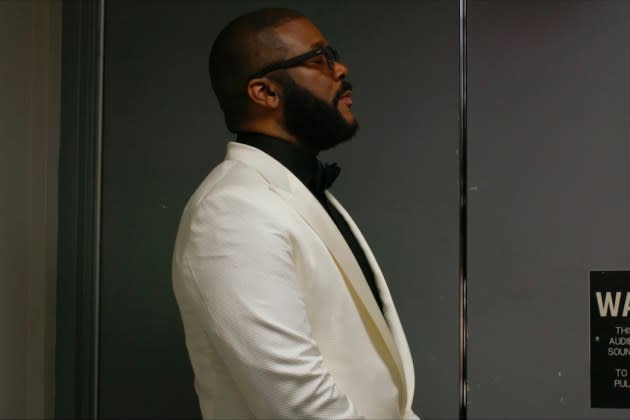‘Maxine’s Baby: The Tyler Perry Story’ Review: Adoring Doc Shows How Trauma Shaped the Showbiz Disruptor
- Oops!Something went wrong.Please try again later.

Ultra-prolific writer-director, fiercely independent producer, pioneering entrepreneur, self-made studio chief. Any and all of these labels apply to Tyler Perry, though the one the boundary-obliterating multi-hyphenate chooses for himself is “Maxine’s Baby” — the same moniker that documentary duo Gelila Bekele and Armani Ortiz opted to give their motivational profile of Perry, who comes off disarmingly humble for someone who’s achieved so much. While not quite hagiography, the worshipful project is so committed to touting Perry’s accomplishments that it takes the rare step of counting his agents and publicist (whose actual job it is to hype him) among its adoring sources.
Early on, Perry’s plays and films served both to inspire and provide moral example, heavy-handedly addressing topics — such as infidelity, drug addiction and child sexual abuse — that Black audiences were more accustomed to hearing about in church than on the big screen. Today, with two dozen features and a 330-acre movie studio to his name, Perry — the man himself, more than his oeuvre — now fills that role, acting as a symbol of possibility and empowerment, especially to other Black creators.
More from Variety
Director of Tyler Perry Documentary 'Maxine's Baby' Shares Why He Chose to Film His Mentor
Tyler Perry Sets Eight-Picture, First-Look Feature Film Deal With Netflix
Critics have not been kind to Perry, who staged his first play, “I Know I’ve Been Changed,” back in 1992 to an almost empty house. Instead of worrying about reviews, Perry focused on what his audiences wanted, producing family-friendly melodramas with low-hanging laughs. “Maxine’s Baby” describes the “birth” and rapid development of his signature character, Madea, a temperamental but loving old Black woman who differed from the fat-suit harpies embodied by Martin Lawrence and Eddie Murphy in that she wasn’t just a punchline. After blowing pretty much any problem out of proportion, Madea ultimately made her community better.
Perry’s billionaire status has often been begrudgingly described as the empire that Madea built. While that persona — six-and-a-half feet of gun-waving, Gospel-misquoting attitude in a housedress — is undoubtedly the most recognizable of the dozens he’s created, his success stems more from his work ethic than from the material itself. For years, Perry traveled the so-called Chitlin’ Circuit, playing hundreds of shows a year to predominantly Black audiences. That was how, when the time came to make his first feature for Michael Paseornek at Lionsgate, Perry had the fan base in place to open at No. 1.
While Madea may have been a broad caricature, Perry’s scripts made a point of celebrating women in the African American community, starting with his mother. Originally named Emmitt Perry Jr., the New Orleans-born survivor describes his painful upbringing, marked by harsh beatings from his father. Despite this and other traumas omitted here, Perry swore to provide for his mother, Maxine, as well as the man who’d mistreated and demeaned him all those years. When co-director Ortiz asks him to go deep, Perry resists. “Are you really trying that on me right now?” he asks, obliging the helmers to dig up interviews he did with Oprah Winfrey and others to find the candid childhood details.
Cousin Lucky Johnson takes the filmmakers to the house where Perry grew up, sharing impressions of “Junior” and corroborating his accounts of abuse. From the sound of things, Perry’s dad was a real piece of work, punishing the boy for reasons beyond his control. The doc shows the hideout under the house where he tried to avoid his father’s wrath, and reiterates how low things got for Perry at one point, when he was reduced to living in his car. Most fans know that aspect of his rags-to-riches story, though it’s doubtful they’ve ever seen the earliest Perry performance captured on tape: a hammy solo at Greater St. Stephen Baptist Church that shows him impervious to embarrassment.
That was back when Perry was still dreaming of becoming a preacher. After his trial sermon went badly, he switched to theater, finding a way to work his religious beliefs into the scripts he was writing. It’s not often that celebrities call attention to their faith the way Perry does, but then, hardly anything about him aligns with the conventional wisdom of the industry. Relying on his publicist and business partners for explanations, the movie outlines the myriad ways Perry has defied traditional industry practices, from gambling on the risky 10/90 model for TV series to constructing a massive studio 2,000 miles from Hollywood.
“Maxine’s Baby” covers a lot of ground in nearly two hours, and much of the footage appears to have been pulled from other sources (there’s surprisingly little from Perry’s filmography, meaning audiences unfamiliar with his oeuvre don’t get much introduction to his style). The movie doesn’t actually make a case for him as an artist — he works so fast, a lot of the work doesn’t hold up — but cements his place in history by extensively documenting the opening of Tyler Perry Studios. Not since the era of Chaplin, Griffith, Fairbanks and Pickford has an actor-creator taken his destiny in hand quite like this.
These days, it’s Perry who’s uniting artists. The fact that he invited so many African American icons to the opening — from Oprah Winfrey and Whoopi Goldberg to Sidney Poitier and Beyoncé, not to mention Spike Lee and Barack Obama — sends a powerful message as to what Black creators can achieve, now that Perry has paved the way. Just as those names once motivated him, “Maxine’s Baby” ensures that Tyler Perry will inspire others.
Best of Variety
Sign up for Variety’s Newsletter. For the latest news, follow us on Facebook, Twitter, and Instagram.
